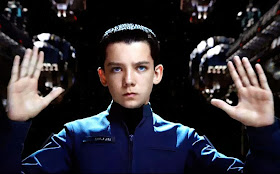Earth has been invaded twice by an alien race. Now, believing
that the best defense is a good offense, humanity has banded together and sent
a fleet of warships to the alien home world. But they need someone to command
the troops. An elaborate series of training programs and schools has been
created to build up – and whittle down – the youth of the world, with the hopes
that it will ultimately result in one very specialized prodigy who will become
the commander of the fleet. Andrew Wiggin is in grade school. Throughout his
training, he is bullied. He fights back, but only because he wants the bullying
to stop. But the ferocity with which he fights back earns the attention of the
international military. He travels to space to enroll in the final stages of
training for command.
The Adoption
Connection
Humanity is fully depending on children to save them. The
film shows the damage this causes. Adoption isn’t part of the Ender’s Game
story (at least, not in the film), but the film does remind me that some
prospective adoptive parents have high expectations that the children they
adopt will bring them joy, healing or fulfillment. That’s too much to expect of
kids; adoption needs to be about meeting a kid’s need for a family, rather than
meeting a family’s need for a child.
Ender is taken from his family by government officials. He
is only allowed very minimal contact with his sister; otherwise, he has no
contact with his family.
Strong Points
Ender is a good kid. He embraces the belief that winning isn’t
the only thing that matters – it’s how you win. He acknowledges – and demonstrates
– that he would rather understand his attackers and find peace with them, rather
than destroy them.
I love the books in the Ender’s Game series. They are
stories of insight, introspection and redemption. Ender’s Game is only the
first in a series of books which become progressively deeper, but even Ender’s
Game does a fine job of creating a believable future universe and showing the
inmost thoughts of a conflicted youth. The film doesn’t really capture Ender’s essence,
but it does a beautiful job of creating the universe that I’ve loved for so
long.
The film revolves around the fact that society has put all
of their faith, and all of their expectations, on children. The children are
expected to save the world. And it’s so good that the film questions this and
shows the way in which society’s expectations hurt Andrew.
Challenges and Weak
Points
There is quite a bit of kid-on-kid violence, including one
scene where Andrew’s older brother chokes him. This, and the fact that Andrew
is separated from his family by government officials, could be difficult for kids
who have come through foster care.
Ender does not get to reunify with his family.
Recommendation
The film suggests that “being right” doesn’t justify
violence. It suggests that we can make amends for things we do that cause pain.
It’s a good film, and it’s worth seeing. The real adoption-reflection moments
are probably more for adults; as you watch the film and see the International
Fleet’s motivation in their work with children, consider the various reasons
that people pursue adoption.
Questions
As you pursue adoption, what are
your expectations? Are you expecting to meet children’s needs, or are you
expecting children to fill holes in your own life? (Wanting to be a parent isn’t
bad! In fact, if I was interviewing an adoption applicant who didn’t want to
parent, I’d have some serious concerns. But it’s worth examining who you have
expectations of – yourself or the child?)
 The International Fleet stopped
Ender from having communication with his family. Did they actually need to?
When you foster or adopt children, will you allow them to have contact with
their birthfamily? Why or why not?
The International Fleet stopped
Ender from having communication with his family. Did they actually need to?
When you foster or adopt children, will you allow them to have contact with
their birthfamily? Why or why not?
New to Adoption
at the Movies? Check out the Adoption Movie Guides on the menu bar. Also, like Adoption at the Movies on Facebook, and follow us on Twitter for updates, thoughts, and more.




No comments:
Post a Comment